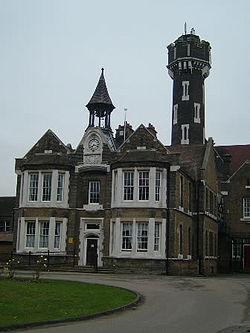
Stone House Hospital
Encyclopedia

Dartford
Dartford is the principal town in the borough of Dartford. It is situated in the northwest corner of Kent, England, east south-east of central London....
, Kent
Kent
Kent is a county in southeast England, and is one of the home counties. It borders East Sussex, Surrey and Greater London and has a defined boundary with Essex in the middle of the Thames Estuary. The ceremonial county boundaries of Kent include the shire county of Kent and the unitary borough of...
, in the United Kingdom
United Kingdom
The United Kingdom of Great Britain and Northern IrelandIn the United Kingdom and Dependencies, other languages have been officially recognised as legitimate autochthonous languages under the European Charter for Regional or Minority Languages...
. As of November, 2007 the hospital has been closed, and bids have been taken for its redevelopment to house luxury flats.
Stone House was originally constructed between 1862 and 1866 at the behest of the London Commissioners in Lunacy
Commissioners in Lunacy
The Commissioners in Lunacy or Lunacy Commission were a UK public body established by the Lunacy Act 1845 to oversee asylums and the welfare of mentally ill people. It succeeded the Metropolitan Commissioners in Lunacy.-Establishment:...
to provide for pauper lunatics from the London
London
London is the capital city of :England and the :United Kingdom, the largest metropolitan area in the United Kingdom, and the largest urban zone in the European Union by most measures. Located on the River Thames, London has been a major settlement for two millennia, its history going back to its...
area at a cost of £65,000 The buildings were designed in a Tudor Revival architecture style by James Bunstone Bunning, and the facility accommodated 220 patients. The asylum grounds, at first 33 acres (133,546.4 m²) and later expanded to 140 acre (0.5665604 km²), included a working farm. Additions to the original buildings were made in 1874, 1878, and 1885, including an expanded female wing and a separate hospital building for patients with infectious diseases.
The first medical superintendent of the Asylum was Dr. Octavius Jepson, who served from the opening of the facility through 1887; on his death twelve years later, he was buried in the asylum's cemetery. He was succeeded by Dr. Ernest White, who served until his retirement in 1904. The third superintendent was Dr. Robert Hunter Steen, who was in turn succeeded in 1924 by Dr. William Robinson. Robinson retired in 1942, but due to wartime staff shortages his permanent replacement, Dr. Hardwick, was not appointed until 1946; on the takeover by NHS his new title became Physician Superintendent, which brought additional powers and responsibilities. He was succeeded upon his retirement in 1959 by Dr. Cates (1959–1963), who was the last to hold the title, as the NHS decided to delegate day-to-day operations to a chief Consulting Psychiatrist.
After 1892, the asylum was able to take "private" patients (patients whose fees were paid by their families, or from pensions). The influx of private patients resulted in a budget surplus, and enabled expansion and improvements of the asylum's facilities. In 1924 the facility was renamed the City of London Mental Hospital, and in 1948 it was taken over by the new National Health Service
National Health Service
The National Health Service is the shared name of three of the four publicly funded healthcare systems in the United Kingdom. They provide a comprehensive range of health services, the vast majority of which are free at the point of use to residents of the United Kingdom...
and became known as Stone House Hospital. A 1998 assessment by Thames Healthcare suggested that the hospital was not suited for modern healthcare; plans for the hospital's closure were initiated in 2003 by West Kent NHS.
Among its most famous patients was the poet and composer Ivor Gurney
Ivor Gurney
Ivor Bertie Gurney was an English composer and poet.-Life:Born at 3 Queen Street, Gloucester in 1890, the second of four children of David Gurney, a tailor, and his wife Florence, a seamstress, Gurney showed musical ability early...
, who resided there from 1922 until his death in 1937.
External links
- County Asylums Website page on Stone House Hospital.

